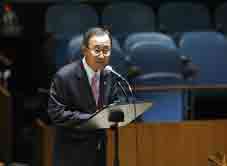UN sees for itself, and is not impressed
By David Matsaberidze
Thursday, September 18

Led by the UN Office for the Coordination of Humanitarian Affairs (OCHA), the team comprises representatives from UNHCR, the UN Children’s Fund (UNICEF), the UN Development Programme (UNDP), the World Health Organization (WHO) and the World Food Programme (WFP), as well as the Office of the High Commissioner for Human Rights (OHCHR). Speaking to UN Radio on September 17, the Secretary-General said that given the situation, “it is absolutely necessary that we continue to discharge our observation mission there, as well as providing humanitarian assistance.” The mission will compile a preliminary report on the disbursement of the US 59 Million humanitarian aid, despatched on August 18, and will complete its tour by visiting Moscow and Tbilisi.
The UN Refugee Agency (UNHCR) has also been able to gain access to the villages of Karaleti, Tkiavi, Kitsnisi and Dzevera, which are still occupied by Russian forces. Teams entered this so-called “buffer zone” north of the town of Gori, where thousands uprooted by last month’s fighting have taken shelter, after having been unable to access the Russian-controlled area for weeks due to security concerns. “These first UN missions are an important step in achieving full access,” UNHCR spokesperson William Spindler told a news conference in Geneva, adding that the agency now plans to conduct regular assessment missions to the buffer zone between Gori and the breakaway region of South Ossetia.
“In the villages closer to Gori most residents appear to have returned already. In the Karaleti area, seven kilometres from Gori, up to 80% of the population is back. Deeper inside the buffer zone, however, the rate of return is considerably lower, as for instance in Kitsnisi, where less than 10% of the villagers have returned so far,” Spindler reported, stressing that the low rate of population return is due to the high level of fear which still prevails among people. Looting, beating and marauding are still commonplace in this area. Villagers informed the agency that 70 to 80 per cent of this year’s harvest has gone, and a lot of mines and unexploded ordnance prevent people from going into their fields.
According to Spindler, the destruction of buildings and houses “is not as widespread as was initially feared and varies from village to village.” In Karaleti a UNHCR team counted 29 houses destroyed, out of some 600 there. In Kitsnisi, only a few buildings were burned or bombed, “while more material and psychological damage have been caused by lootings and destruction inside people's houses.” School buildings have remained almost intact, but added that the majority of people returning are adults and schools remain closed. “The first assessments show that returnees to the villages in the buffer zone need rehabilitation and reconstruction assistance and the provision of supplementary food items and firewood,” Spindler stressed. According to his information, villagers now rely on firewood for cooking and heating, since the local gas pipeline is no longer functioning. The price of firewood has thus risen by 50 per cent, and there are also no health services inside the buffer zone, the population depending on medical assistance from Gori.
Following the detailed profiling of internally displaced persons in Georgia completed last week, the UN humanitarian assessment mission has revised the number of people displaced by the August conflict. It now says that 192,000 people were forced to flee their homes, including 127,000 who are displaced in Georgia proper, 30,000 within South Ossetia and another 35,000 who have fled to North Ossetia in the Russian Federation. Most of those who fled to North Ossetia have already returned.
The need for sending the UN mission was first voiced on September 11, when Ban Ki-Moon said that “he hopes to send a fact-finding mission to Georgia, where U.N. humanitarian aid staff had difficulty accessing Russian-controlled areas.” The UN Secretary-General’s most recent statement concerning the mission uses the phrases “South Ossetia, Georgia” and “South Ossetia (Georgia)” when referring to that region, firmly recognizing that the so called “independent and sovereign state” is in fact part of Georgia.
